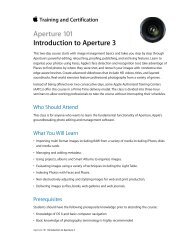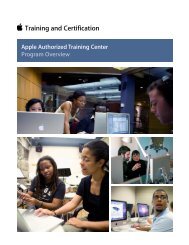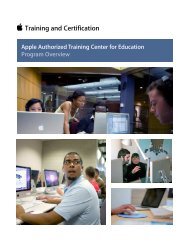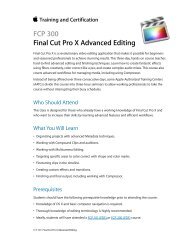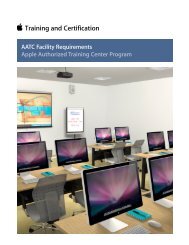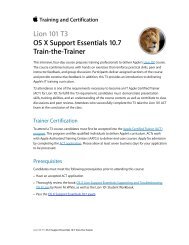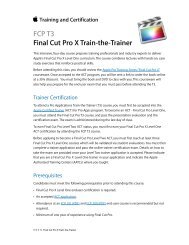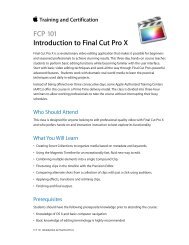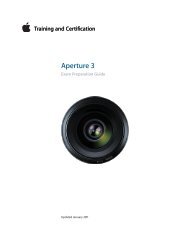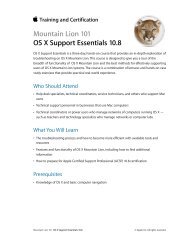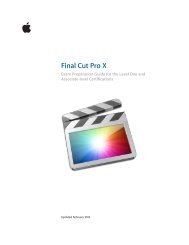OS X Support Essentials 10.8 - Training - Apple
OS X Support Essentials 10.8 - Training - Apple
OS X Support Essentials 10.8 - Training - Apple
Create successful ePaper yourself
Turn your PDF publications into a flip-book with our unique Google optimized e-Paper software.
<strong>OS</strong> X <strong>Support</strong> <strong>Essentials</strong> <strong>10.8</strong> Exam Preparation Guide<br />
2. Four steps you should take before upgrading a system to<br />
<strong>OS</strong> X Mountain Lion are:<br />
• Install <strong>Apple</strong> software and firmware updates<br />
• Verify application compatibility<br />
• Back up important files and folders<br />
• Document critical settings.<br />
3. You can identify a Mac computer’s firmware version by<br />
opening the full system report in the System Information<br />
application or System Profiler application. You can verify if a<br />
Mac computer’s firmware is up to date by visiting the <strong>Apple</strong><br />
support website, which maintains a list of available firmware<br />
updates.<br />
4. Single-partition drives are easier to set up initially, but they<br />
aren’t as flexible for administration and maintenance.<br />
Multiple-partition drives require repartitioning during setup<br />
but provide several separate partitions, which can be used to<br />
segregate user data and host multiple operating systems.<br />
5. The <strong>OS</strong> X Mountain Lion installer can be purchased and<br />
downloaded only from the Mac App Store.<br />
6. During installation of <strong>OS</strong> X Mountain Lion, the only optional<br />
choice is to define an installation destination other than the<br />
Mac computer’s current default system disk.<br />
Lesson Three review questions<br />
After completing Lesson Three, you should be able to answer the following<br />
questions.<br />
1. What key features do you gain by setting up iCloud?<br />
2. What three primary sources can Migration Assistant pull<br />
from?<br />
3. What are the five System Preferences categories?<br />
4. How do the four default System Preferences categories differ?<br />
5. What is a configuration profile? How are configuration<br />
profiles managed?<br />
6. Where can you locate the system version number, build<br />
number, and serial number? What is the significance of these<br />
numbers?<br />
Answers<br />
1. iCloud is a free service from <strong>Apple</strong> that provides cloud<br />
storage and communication services for applications<br />
(including Mail, Contacts, Calendar, Reminders, Notes, Safari,<br />
Photo Stream, and any other applications that support iCloud<br />
integration). iCloud also provides Find My Mac technology for<br />
help locating a lost or stolen system.<br />
8



